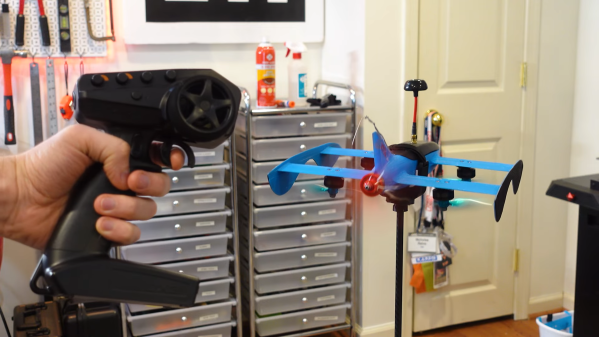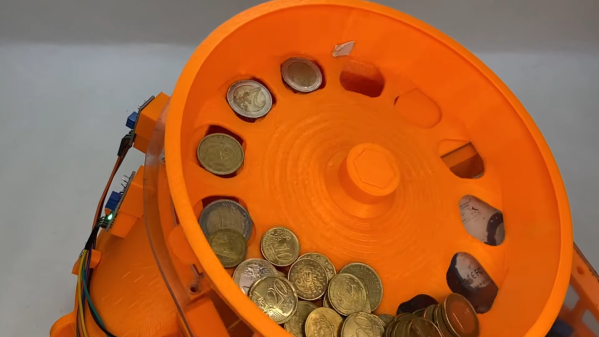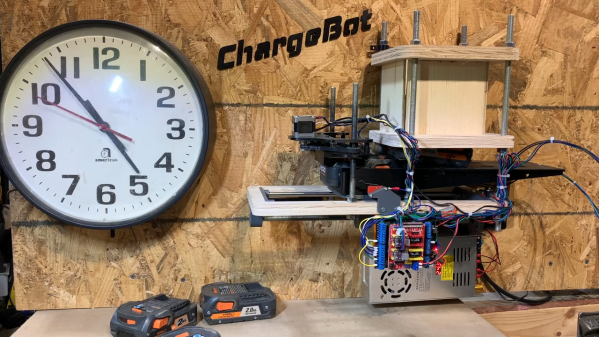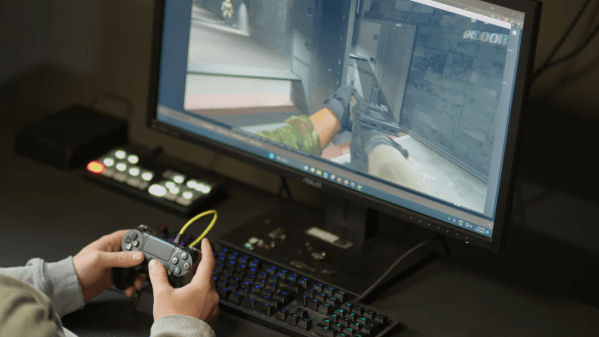The Great Automotive AM Radio War of 2023 rages on, with the news this week that Ford has capitulated, at least for now. You’ll recall that the opening salvo came when the US automaker declared that AM radio was unusable in their EV offerings thanks to interference generated by the motor controller. Rather than fixing the root problem, Ford decided to delete the AM option from their EV infotainment systems, while letting their rolling EMI generators just keep blasting out interference for everyone to enjoy. Lawmakers began rattling their sabers in response, threatening legislation to include AM radio in every vehicle as a matter of public safety. Ford saw the writing on the wall and reversed course, saying that AM is back for at least the 2024 model year, and that vehicles already delivered without it will get a fix via software update.
Author: Dan Maloney3367 Articles
Fly Like You Drive With This Flying RC Drift Car
So it’s 2023, and you really feel like we should have flying cars by now, right? Well, as long as you ignore the problem of scale presented by [Nick Rehm]’s flying RC drift car, we pretty much do.
At first glance, [Nick]’s latest build looks pretty much like your typical quadcopter. But the design has subtle differences that make it more like a car without wheels. The main difference is the pusher prop at the aft, which provides forward thrust without having to pitch the entire craft. Other subtle clues include the belly-mounted lidar and nose-mounted FPV camera, although those aren’t exactly unknown on standard UAVs.
The big giveaway, though, is the RC car-style remote used to fly the drone. Rather than use the standard two-joystick remote, [Nick] rejiggered his dRehmFlight open-source flight control software to make operating the drone less like flying and more like driving. The lidar is used to relieve the operator of the burden of altitude keeping by holding the drone at about a meter or so off the deck. And the video below shows it doing a really good job of it, for the most part — with anything as complicated as the multiple control loops needed to keep this thing in the air, it’s easy for a sudden input to confuse things.
We have to admit that [Nick]’s creation looks like a lot of fun to fly, or drive — whichever way you want to look at it. Either way, we like the simplification of the flight control system and translating the driving metaphor into flying — it seems like that’ll be something we need if we’re ever to have full-size flying cars.
Continue reading “Fly Like You Drive With This Flying RC Drift Car”
Getting Into NMR Without The Superconducting Magnet
Exploring the mysteries of quantum mechanics surely seems like an endeavor that requires room-sized equipment and racks of electronics, along with large buckets of grant money, to accomplish. And while that’s generally true, there’s quite a lot that can be accomplished on a considerably more modest budget, as this as-simple-as-it-gets nuclear magnetic resonance spectroscope amply demonstrates.
First things first: Does the “magnetic resonance” part of “NMR” bear any relationship to magnetic resonance imaging? Indeed it does, as the technique of lining up nuclei in a magnetic field, perturbing them with an electromagnetic field, and receiving the resultant RF signals as the nuclei snap back to their original spin state lies at the heart of both. And while MRI scanners and the large NMR spectrometers used in analytical chemistry labs both use extremely powerful magnetic fields, [Andy Nicol] shows us that even the Earth’s magnetic field can be used for NMR.
[Andy]’s NMR setup couldn’t be simpler. It consists of a coil of enameled copper wire wound on a 40 mm PVC tube and a simple control box with nothing more than a switch and a couple of capacitors. The only fancy bit is a USB audio interface, which is used to amplify and digitize the 2-kHz-ish signal generated by hydrogen atoms when they precess in Earth’s extremely weak magnetic field. A tripod stripped of all ferrous metal parts is also handy, as this setup needs to be outdoors where interfering magnetic fields can be minimized. In use, the coil is charged with a LiPo battery for about 10 seconds before being rapidly switched to the input of the USB amp. The resulting resonance signal is visualized using the waterfall display on SDR#.
[Andy] includes a lot of helpful tips in his excellent write-up, like tuning the coil with capacitors, minimizing noise, and estimating the exact resonance frequency expected based on the strength of the local magnetic field. It’s a great project and a good explanation of how NMR works. And it’s nowhere near as loud as an MRI scanner.
New Drug Has Potential As Dirty Bomb Antidote
It perhaps goes without saying that one nuclear bomb can really ruin your day. The same is true for non-nuclear dirty bombs, which just use conventional explosives to disperse radioactive material over a wide area. Either way, the debris scattered by any type of radiation weapon has the potential to result in thousands or perhaps millions of injuries, for which modern medicine offers little in the way of relief.

But maybe not for long. A Phase 1 clinical trial is currently underway to see if an oral drug is able to scour radioactive elements from the human body. The investigational compound is called HOPO 14-1, a chelating agent that has a high affinity for metals in the actinide series, which includes plutonium, uranium, thorium, and cerium curium. Chelating agents, which are molecules that contain a multitude of electron donor sites, are able to bind to positively charged metal ions and make the soluble in aqueous solutions. Chelators are important in food and pharmaceutical processing — read the ingredients list on just about anything from a can of soda to a bottle of shampoo and you’re likely to see EDTA, or ethylenediaminetetraacetic acid, which binds to any metal ions that make it into the product, particularly iron ions that come from the stainless steel plumbing used in processing equipment.
The compound under evaluation, HOPO 14-1, is a powerful chelator of metal ions. Its structure is inspired by natural chelators produced by bacteria and fungi, called siderophores, which help the microorganisms accumulate iron. Its mechanism of action is to sequester the radioactive ions and make them soluble enough to be passed out of the body in the urine, rather than to have the radioactive elements carried around the body and incorporated into the bones and other tissues where they can cause radiation damage for years.
HOPO 14-1 has a number of potential benefits over the current frontline chelator for plutonium and uranium toxicity, DTPA or diethylenetriaminepentaacetic acid. Where DTPA needs to be injected intravenously to be effective, HOPO 14-1 can be made into a pill, making stockpiling and administering the drug easier. If, of course, it passes Phase 1 safety trials and survives later trials to determine efficacy.
Automatic Coin Sorter Brings Order To Your Coin Jar
Few things hold as much promise as the old coin jar. Unfortunately, what’s generally promised is tedium, as one faces the prospect of manually sorting, counting, and rolling the accumulated change of cash transactions past. Unless, of course, you’ve got a fancy automatic coin sorter like this one.
True, many banks have automatic coin sorters, but you generally have to be a paying customer to use one. And there’s always Coinstar and similar kiosks, but they always find a way to extract a fee, one way or another. [Fraens] decided not to fall for either of those traps and roll his own machine, largely from 3D-printed parts. The basic mechanism is similar to that used in commercial coin counters, with an angled bowl rotating over an array of holes sized to fit various coins. Holes in the bottom of the feed bowl accept coins fed from a hopper and transport them up to the coin holes. The smallest coins fall out of the bowl first, followed by the bigger coins; each coin drops into a separate bin after passing through an optical sensor to count the number of each on an Arduino. Subtotals and a grand total of the haul are displayed on a small LCD screen. The video below shows the build and the sorter in operation.
[Fraens] built this sorter specifically for Euro coins, but it should be easy enough to modify the sorting slots for different currencies. It’s not the first coin sorter we’ve seen, of course, and while we applaud its design simplicity and efficient operation, it can’t hold a candle to the style of this decidedly less practical approach.
Continue reading “Automatic Coin Sorter Brings Order To Your Coin Jar”
Battery Bot Makes Sure Cordless Tool Packs Are Always Topped Up
There was a time not that long ago when every tool was cordless. But now, cordless power tools have proliferated to the point where the mere thought of using a plain old wrist-twisting screwdriver is enough to trigger a bout of sympathetic repetitive injury. And the only thing worse than that is to discover that the batteries for your tools are all dead.
As [Lance] from the “Sparks and Code” channel freely admits, the fact that his impressive collection of batteries is always dead is entirely his fault, and that’s what inspired his automatic battery charging robot. The design is pretty clever; depleted batteries go into a hopper, under which is a 3D-printed sled. Batteries drop down into the sled, which runs the battery out from under the hopper to the charging station, which is just the guts of an old manual charger attached to a lead screw to adjust the height of the charging terminals for different size batteries. When the battery is charged, the sled pushes it a little further into an outfeed hopper before going back to get another battery from the infeed side.
Of course, that all vastly understates the amount of work [Lance] had to put into this. He suffered through a lot of “integration hell” problems, like getting the charger properly connected to the Arduino running the automation. But with a lot of tweaking, he can now just dump in a bunch of depleted packs and let the battery bot handle everything. The video after the break shows all the gory details.
Of course, there’s another completely different and much simpler solution to the dead battery problem.
Continue reading “Battery Bot Makes Sure Cordless Tool Packs Are Always Topped Up”
Hall Sensors Offer Drop-In Replacement For Drifting Game Console Joysticks
No bananas were harmed in the making of this Hall effect drift-proof joystick replacement. OK, not really — two bananas were turned to mush. But it’s OK, they’re just bananas, after all.
Why bananas, you ask? Because [Marius Heier] uses them to demonstrate what we all intuitively know — that rubbing something over and over again tends to wear it away — but engineers seem to have forgotten. Wear such as this, with resistance material rather than fruits, is what causes the dreaded drift, a problem that the world collectively spends $20 billion a year dealing with, according to [Marius].
While numbers like that seem to be firmly in class-action lawsuit territory, sometimes it’s best to take matters into your own hands and not wait for the courts. The fix [Marius] shows here is to yank the potentiometers off a PS4 joystick and replace them with contactless Hall effect sensors. The end of the shaft for each axis gets a diametral neodymium magnet attached to it, while a 3D printed bracket holds a tiny custom PCB in close proximity. The PCB has an AS5600 Hall sensor, which translates the shaft angle to an analog voltage output. After programming the chip over its I2C bus, the sensor outputs a voltage proportional to the angle of each shaft, just like the original pots, but without all the wear and tear.
While [Marius] is selling these as drop-in replacements for PS4 controllers, he plans to release all the design files so you can build one yourself. He also has his sights set on replacements for PS5 and Xbox controllers, so watch for those. This isn’t his first foray into joystick hacking, having shared his 3D Hall effect and haptic feedback joysticks with us previously.
Continue reading “Hall Sensors Offer Drop-In Replacement For Drifting Game Console Joysticks”

















